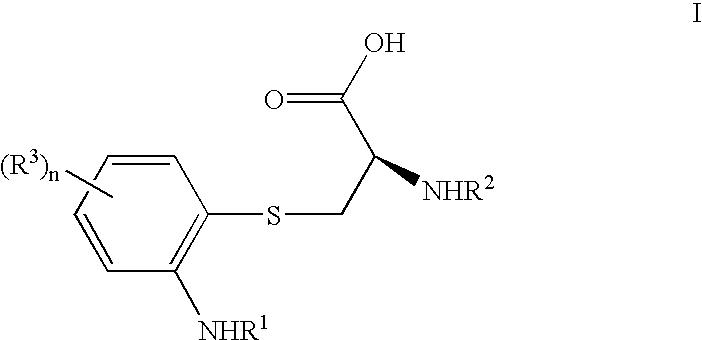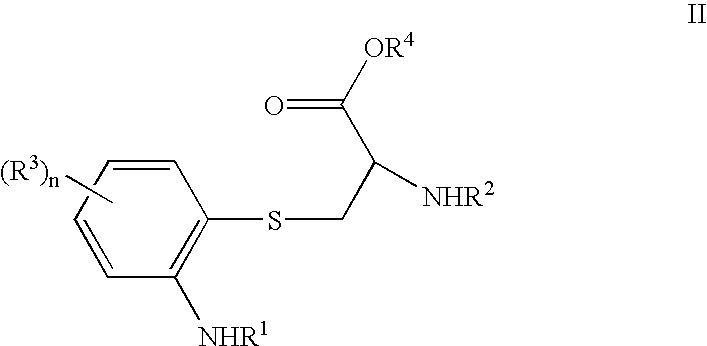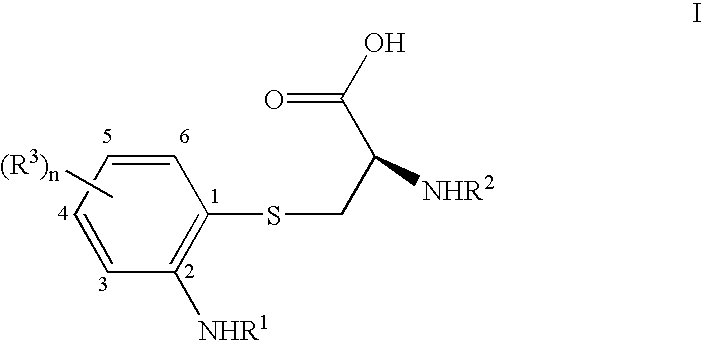Substituted 2-amino-3-(2-amino-phenylsulfanyl)-propionic acids
a technology of phenylsulfanyl and substituted amino acids, which is applied in the direction of biocide, peptide/protein ingredients, genetic material ingredients, etc., can solve the problems of low yield and decomposition of starting materials
- Summary
- Abstract
- Description
- Claims
- Application Information
AI Technical Summary
Problems solved by technology
Method used
Image
Examples
example 1
Preparation of the Starting Material
(S)-3-(4-Bromo-2-nitro-phenylsulfanyl)-2-tert-butoxycarbonylamino-propionic acid methyl ester
[0080]
[0081]The reaction was carried out as described in M. K. Schwarz et al., J. Org. Chem. 1999, 64, 2219–2231. To a solution of commercially available BOC-Cysteine-Methylester (27.38 g, 116.35 mmol, 1 eq), N-Ethyldiisopropylamine (DIPEA) (4.4 mL, 25.75 mmol, 2.5 eq) in EtOH (310 mL) was added 5-bromo-2-fluoronitrobenzene (25.62 g; 116,45 mmol; 1 eq) and heated at 110° C. for 3 h. The progress of the reaction was monitored by HPLC. The solvent was evaporated to a red-brown oil and this was partitioned between water (600 mL) and ethyl acetate (3×300 mL). Drying (Na2SO4), and evaporation gave crude product which was recrystallised with cyclohexane to give yellow crystals (38.75 g, 77%). Analytical data: 1H-NMR (CDCl3, 400 MHz): 1.430 (s, 9H, O(CH3)); 3.350 (dd, 1H, H(4′), J4′-4″=5.2 Hz, J4′-5=14.4 Hz); 3.500 (dd, 1H, H(4″), J4″-4′=5.2 Hz, J4″-5=14.4 Hz); 3...
example 2
(S)-3-(2-Amino-4-bromo-phenylsulfanyl)-2-tert-butoxycarbonylamino-propionic acid methyl ester
[0082]
[0083]The reaction is carried out as described in J. Slade et.al., J. Med. Chem. 1985, 28, 1517–1521). A mixture of the nitro compound from above (40.34 g, 92.6 mmol, 1 eq), NH4Cl (19.81 g, 370.6 mmol, 4 eq) is added and Zn (79.37 g, 1.204 mmol, 13 eq) in MeOH (950 mL) was heated at reflux for 16 h and the resultant mixture filtered through Celite and washed with boiling MeOH. After concentration, the crude product was partitioned between ethyl acetate and a NaHCO3 (aq.). The resultant oil was chromatographed using ethyl acetate / hexane / 3% triethylamine) to give the product (21.11 g, 56%). Analytical data: 1H-NMR (CDCl3, 400 MHz): 1.395 (s, 9H, O(CH3)); 3.185 (d, 2H, H(4), J4-5=4 Hz); 3.617 (s, 3H, OCH3); 4.446 (s, 2H, H(7)); 4.528 (m, 1H, H(5)); 5.502 (d, 1H, H(6), J6-5=8 Hz); 6.793 (dd, 1H, H(3), J3-2=2 Hz, J3-1=8.4 Hz);6.868 (d, 1H, H(3), J3-2=2 Hz), 7.225 (d, 1H, H(1), J1-2 =8.4 Hz)...
example 3.1
Large Scale Enzymatic Hydrolysis
(S)-3-(2-Amino-4-bromo-phenylsulfanyl)-2-tert-butoxycarbonylamino-propionic acid
[0084]
[0085]19.9 g (48.02 mmol) of N-tert-butoxycarbonyl-3-(2-amino-4-bromophenylthio)-L-alanine methyl ester (97.8%) was dissolved in 750 ml TBME and emulsified in 3 L buffer solution (0.1M sodium chloride, 20 mM sodium phosphate pH 7.5) under vigorous stirring. 12.0 ml Alcalase 2.4 L and 30 mg Substilisin A [both enzyme preparations are subtilisin Carlsberg from Novo Nordisk] were added and the pH was maintained at 7.5 under vigorous stirring by the controlled addition (pH-static) of 1.0N sodium hydroxide solution. After 7d 44.75 ml of 1.0N sodium hydroxide solution was consumed and the conversion degree was >99% (HPLC analysis). The biphasic reaction mixture was separated. The aqueous phase was washed briefly with 1 L TBME for the separation of small amounts of lipophilic impurities and traces of the remaining substrate. The combined organic phases were extracted with 1...
PUM
| Property | Measurement | Unit |
|---|---|---|
| Fraction | aaaaa | aaaaa |
| Fraction | aaaaa | aaaaa |
| Fraction | aaaaa | aaaaa |
Abstract
Description
Claims
Application Information
 Login to View More
Login to View More - R&D
- Intellectual Property
- Life Sciences
- Materials
- Tech Scout
- Unparalleled Data Quality
- Higher Quality Content
- 60% Fewer Hallucinations
Browse by: Latest US Patents, China's latest patents, Technical Efficacy Thesaurus, Application Domain, Technology Topic, Popular Technical Reports.
© 2025 PatSnap. All rights reserved.Legal|Privacy policy|Modern Slavery Act Transparency Statement|Sitemap|About US| Contact US: help@patsnap.com



